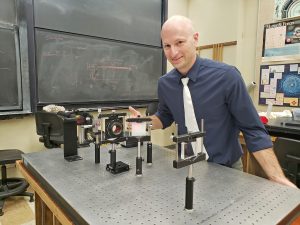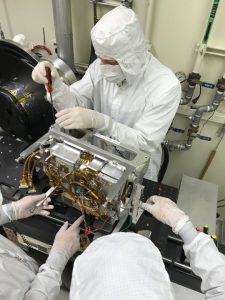
Brian Monacelli, Ph.D., ’05, may have recently helped send a laser-based Raman and fluorescence spectrometer to Mars on the Perseverance rover, but the achievement he’s most proud of might surprise you.
Monacelli’s passion is rooted in teaching and supporting technicians to ensure their success in the workplace. His interest in education began as a youth, influenced by his mother’s diverse and challenging work in special education, but it was augmented significantly when he helped with his classmates’ education as a teaching assistant (TA) at CREOL from 2001-2005. He also was the first student senator from CREOL, serving to assist CREOL students as they worked with other colleges at UCF.
“In most technical fields, especially optics, collaboration is essential,” said Monacelli. “Everyone works together to achieve a project’s goals. Technicians help engineers who help scientists; it is all synergistic.”

Such cooperation is more efficient and most successful if everyone is properly trained and educated. That’s where Monacelli steps in. One of the most impactful experiences of Monacelli’s career has been creating curricula used to teach technicians applied, hands-on laboratory skills.
Monacelli began teaching technicians while working as an optical engineer with U.S. defense contractor Raytheon. Many aerospace technicians were trained to work with mechanical and electrical systems, but they lacked applied knowledge of optics. Raytheon builds optical systems, so their technicians needed to develop new skills. Monacelli volunteered to create and conduct lab-based skills courses to help train these technicians.
“Technicians make scientists’ dreams come true through their indispensable hands-on work in the lab, and via measurements they make in the field,” said Monacelli. “I enjoy fostering the fundamental processes that help build new technical systems.”
Monacelli brings an array of experiences in optics to the classroom, having engineered a variety of systems, including a recent endeavor for NASA’s Mars 2020 rover, Perseverance. He works as an optical engineer and technical supervisor at Jet Propulsion Laboratory (JPL), where he helped build the SHERLOC instrument, an ultraviolet laser-based Raman and fluorescence spectrometer. The data gathered by SHERLOC will be used by Earth-based scientists to determine whether there are signs of past life on Mars.
In 2013, representatives from the National Center for Optics and Photonics Education (OP-TEC), a grantee of the National Science Foundation, approached Monacelli with an offer to help fund his work in creating a degree program in optics technician education. This program was to be based on the applied-skills courses that Monacelli originally developed while at Raytheon.
Since then, Monacelli’s teaching career has taken off. Since 2007, Monacelli has been teaching optics courses at Irvine Valley College before moving the laser technology program to Pasadena City College (PCC) and developing an Associate of Science degree in Laser Technology at the California State level. Through his work, he has taught optics lab skills to employees from organizations such as Lawrence Livermore National Laboratory, Space X, Alcon, Johnson and Johnson, Masimo, Northrup Grumman, Boeing, the US Air Force, and even Disney.
Now as a professor at PCC, Monacelli reflects on why the teachings of his courses are impactful to the technicians that enroll in them.
“Your work as a technician will be much more fruitful if you’re able to communicate clearly and directly with scientists and engineers by speaking the science and understanding the basics of engineering,” said Monacelli. “Effective communication has been a major goal of the laser technology courses I teach.”
Technicians, engineers, and scientists combine skills to form the collaborative force behind the projects that are changing the world. Monacelli’s work with NASA JPL reminds him just how important fostering that collaboration really is.
“As I learned as a TA and student senator for CREOL, it is important to keep your colleagues and your students engaged in learning skills and enhancing collaborations. The most rewarding part of working on SHERLOC was the teamwork required to assemble and alignment the instrument. Three equal types of employee—scientists, engineers, and technicians—put our heads together to make this massive project worthy of operation on Mars. We helped each other to make our vision a reality. Our collaboration was arguably the most essential part of the project because we were able to communicate across our individual specialties to create this incredibly complex piece of technology that we hoped would play a major role in the future of Mars exploration.”